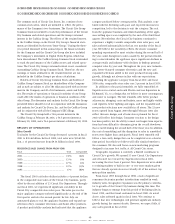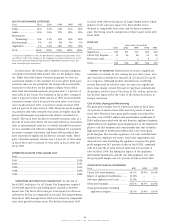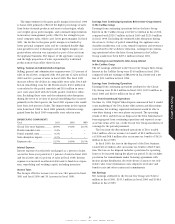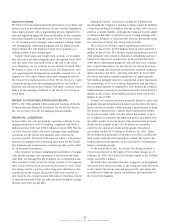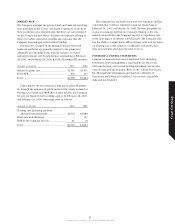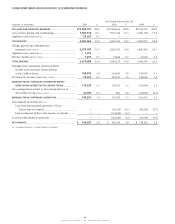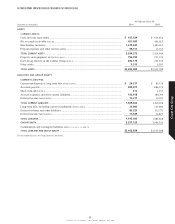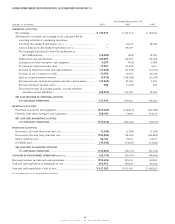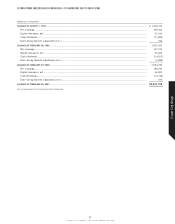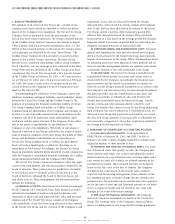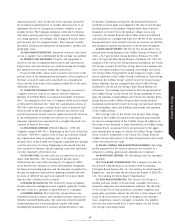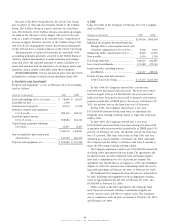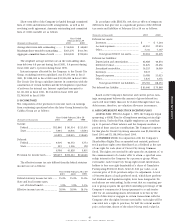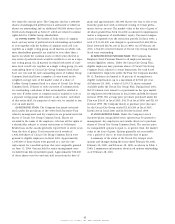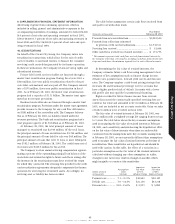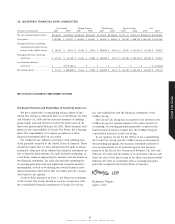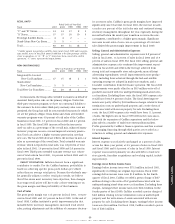CarMax 2001 Annual Report Download - page 62
Download and view the complete annual report
Please find page 62 of the 2001 CarMax annual report below. You can navigate through the pages in the report by either clicking on the pages listed below, or by using the keyword search tool below to find specific information within the annual report.
Circuit City Group
approximates fair value. Credit risk is the exposure created by
the potential nonperformance of another material party to an
agreement because of changes in economic, industry or geo-
graphic factors. The Company mitigates credit risk by dealing
only with counterparties that are highly rated by several finan-
cial rating agencies. Accordingly, the Company does not antici-
pate material loss for nonperformance. The Company broadly
diversifies all financial instruments along industry, product and
geographic areas.
(D) MERCHANDISE INVENTORY: Inventory is stated at the lower
of cost or market. Cost is determined by the average cost method.
(E) PROPERTY AND EQUIPMENT: Property and equipment is
stated at cost less accumulated depreciation and amortization.
Depreciation and amortization are calculated using the straight-
line method over the assets’ estimated useful lives.
Property held under capital lease is stated at the lower of the
present value of the minimum lease payments at the inception of
the lease or market value and is amortized on a straight-line
basis over the lease term or the estimated useful life of the asset,
whichever is shorter.
(F) COMPUTER SOFTWARE COSTS: The Company accounts for
computer software costs in accordance with the American
Institute of Certified Public Accountants Statement of Position
98-1, “Accounting for the Costs of Computer Software Developed
or Obtained for Internal Use.” Once the capitalization criteria of
SOP 98-1 have been met, external direct costs of materials and
services used in the development of internal-use software and
payroll and payroll-related costs for employees directly involved
in the development of internal-use software are capitalized.
Amounts capitalized are amortized on a straight-line basis over
a period of three to five years.
(G) PRE-OPENING EXPENSES: Effective March 1, 1999, the
Company adopted SOP 98-5, “Reporting on the Costs of Start-Up
Activities.” SOP 98-5 requires costs of start-up activities, includ-
ing organization and pre-opening costs, to be expensed as
incurred. Prior to fiscal 2000, the Company capitalized pre-opening
costs for new store locations. Beginning in the month after the
store opened for business, the pre-opening costs were amortized
over the remainder of the fiscal year.
(H) INCOME TAXES: Income taxes are accounted for in accor-
dance with SFAS No. 109, “Accounting for Income Taxes.”
Deferred income taxes reflect the impact of temporary differ-
ences between the amounts of assets and liabilities recognized
for financial reporting purposes and the amounts recognized for
income tax purposes, measured by applying currently enacted
tax laws. A deferred tax asset is recognized if it is more likely
than not that a benefit will be realized.
(I) REVENUE RECOGNITION: The Circuit City Group recognizes
revenue when the earnings process is complete, generally at either
the time of sale to a customer or upon delivery to a customer.
(J) DEFERRED REVENUE: The Circuit City Group sells its own
extended warranty contracts and extended warranty contracts on
behalf of unrelated third parties. The contracts extend beyond the
normal manufacturer’s warranty period, usually with terms
(including the manufacturer’s warranty period) between 12 and
60 months. Commission revenue for the unrelated third-party
extended warranty plans is recognized at the time of sale because
the third parties are the primary obligors under these contracts.
Inasmuch as Circuit City is the primary obligor on its own
contracts, all revenue from the sale of these contracts is deferred
and amortized on a straight-line basis over the life of the contracts.
Incremental direct costs related to the sale of contracts are deferred
and charged to expense in proportion to the revenue recognized.
(K) INTER-GROUP INTEREST: The Circuit City Group held a 74.6
percent Inter-Group Interest in the CarMax Group at February 28,
2001, a 74.7 percent Inter-Group Interest at February 29, 2000,
and a 76.6 percent Inter-Group Interest at February 28, 1999. For
purposes of the Circuit City Group financial statements, the Circuit
City Group accounts for the Inter-Group Interest in a manner sim-
ilar to the equity method of accounting. Accordingly, the Circuit
City Group’s Inter-Group Interest in the Company’s equity value
that is attributed to the CarMax Group is reflected as “Inter-Group
Interest in the CarMax Group” on the Circuit City Group balance
sheets. Similarly, the net earnings (loss) of the CarMax Group
attributed to the Circuit City Group’s Inter-Group Interest are
reflected as “Net earnings (loss) related to Inter-Group Interest in
the CarMax Group” on the Circuit City Group statements of earn-
ings. All amounts corresponding to the Circuit City Group’s Inter-
Group Interest in the CarMax Group in these Group financial
statements represent the Circuit City Group’s proportional interest
in the businesses, assets and liabilities and income and expenses
of the CarMax Group.
The carrying value of the Circuit City Group’s Inter-Group
Interest in the CarMax Group has been adjusted proportionally
for the net earnings (loss) of the CarMax Group. In addition, in
the event of any dividend or other distribution on CarMax Group
Common Stock, an amount that is proportionate to the aggre-
gate amount paid in respect to shares of CarMax Group Common
Stock would be transferred to the Circuit City Group from the
CarMax Group with respect to its Inter-Group Interest and would
reduce the related book value.
(L) SELLING, GENERAL AND ADMINISTRATIVE EXPENSES: Operating
profits generated by the finance operation are recorded as a
reduction to selling, general and administrative expenses.
(M) ADVERTISING EXPENSES: All advertising costs are expensed
as incurred.
(N) STOCK-BASED COMPENSATION: The Company accounts for
stock-based compensation in accordance with Accounting
Principles Board Opinion No. 25, “Accounting for Stock Issued to
Employees,” and provides the pro forma disclosures of SFAS No.
123, “Accounting for Stock-Based Compensation.”
(O) RISKS AND UNCERTAINTIES: The Circuit City Group is a
leading national retailer of brand-name consumer electronics,
personal computers and entertainment software. The diversity
of the Circuit City Group's products, customers, suppliers and
geographic operations reduces the risk that a severe impact will
occur in the near term as a result of changes in its customer
base, competition, sources of supply or markets. It is unlikely
that any one event would have a severe impact on the Circuit
City Group's operating results.
59
CIRCUIT CITY STORES, INC. 2001 ANNUAL REPORT


